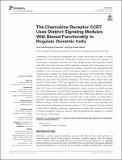Por favor, use este identificador para citar o enlazar a este item:
http://hdl.handle.net/10261/234603COMPARTIR / EXPORTAR:
 SHARE SHARE
 CORE
BASE CORE
BASE
|
|
| Visualizar otros formatos: MARC | Dublin Core | RDF | ORE | MODS | METS | DIDL | DATACITE | |

| Título: | The chemokine receptor CCR7 uses distinct signaling modules with biased functionality to regulate dendritic cells |
Autor: | Rodríguez-Fernández, José Luis CSIC ORCID ; Criado-García, Olga CSIC ORCID | Palabras clave: | Chemotaxis (MeSH ID D002633) C–C chemokine receptor 7 MAPK pathway PI3 K/Akt pathway RhoA pathway Leukocyte Signaling |
Fecha de publicación: | 15-abr-2020 | Editor: | Frontiers Media | Citación: | Frontiers in Immunology 11: 528 (2020) | Resumen: | Chemotaxis is a molecular mechanism that confers leukocytes the ability to detect gradients of chemoattractants. Chemokine receptors are well-known regulators of chemotaxis in leukocytes; however, they can regulate several other activities in these cells. This information has been often neglected, probably due to the paramount role of chemotaxis in the immune system and in biology. Therefore, the experimental data available on the mechanisms used by chemokine receptors to regulate other functions of leukocytes is sparse. The results obtained in the study of the chemokine receptor CCR7 in dendritic cells (DCs) provide interesting information on this issue. CCR7 guides the DCs from the peripheral tissues to the lymph nodes, where these cells control T cell activation. CCR7 can regulate DC chemotaxis, survival, migratory speed, cytoarchitecture, and endocytosis. Biochemical and functional analyses show: first, that CCR7 uses in DCs the PI3K/Akt pathway to control survival, the MAPK pathway to control chemotaxis, and the RhoA pathways to regulate actin dynamics, which in turn controls migratory speed, cytoarchitecture, and endocytosis; second, that these three signaling pathways behave as modules with a high degree of independence; and third, that although each one of these routes can regulate several functions in different settings, CCR7 promotes in DCs a functional bias in each pathway. The data uncover an interesting mechanism used by CCR7 to regulate the DCs, entailing multifunctional signaling pathways organized in modules with biased functionality. A similar mechanism could be used by other chemoattractant receptors to regulate the functions of leukocytes. | Descripción: | 10 p.-1 fig.-1 tab. | Versión del editor: | https://doi.org/10.3389/fimmu.2020.00528 | URI: | http://hdl.handle.net/10261/234603 | DOI: | 10.3389/fimmu.2020.00528 | E-ISSN: | 1664-3224 |
| Aparece en las colecciones: | (CIB) Artículos |
Ficheros en este ítem:
| Fichero | Descripción | Tamaño | Formato | |
|---|---|---|---|---|
| fimmu_rodríguez-fernández_2020.pdf | Artículo principal | 1,1 MB | Adobe PDF |  Visualizar/Abrir |
CORE Recommender
PubMed Central
Citations
24
checked on 09-abr-2024
SCOPUSTM
Citations
30
checked on 25-abr-2024
WEB OF SCIENCETM
Citations
30
checked on 29-feb-2024
Page view(s)
66
checked on 01-may-2024
Download(s)
96
checked on 01-may-2024

